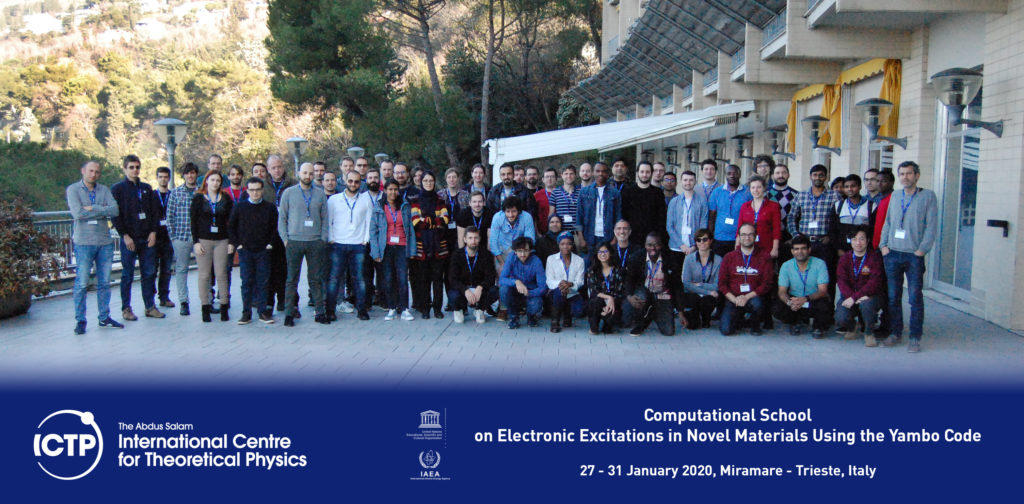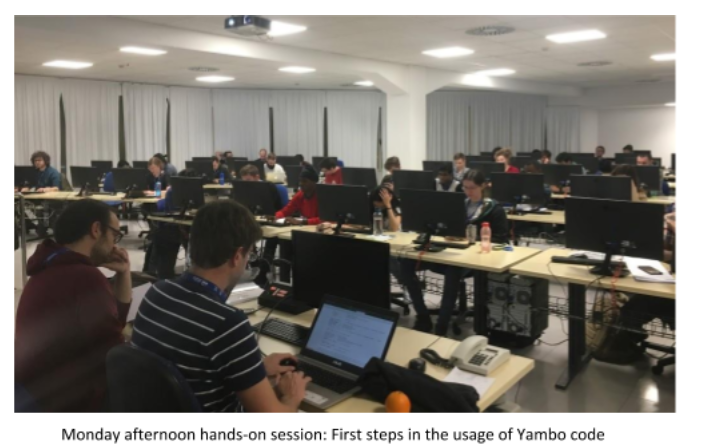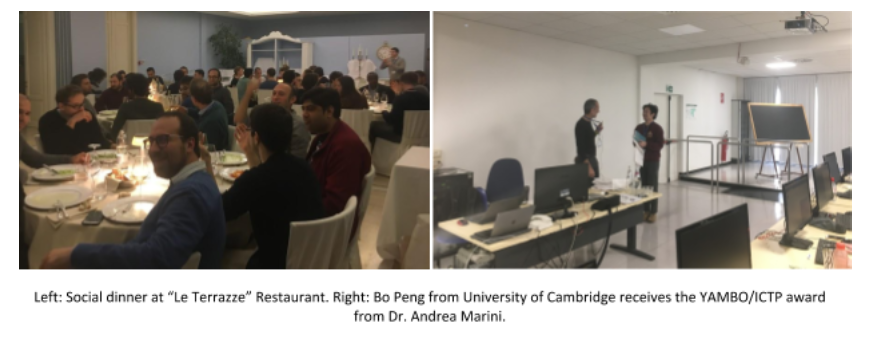From 27th to 31th January 2020 the YAMBO school devoted to first-principles calculations of electronic excited state properties in Novel Materials was held at the Abdus Salam International Center for Theoretical Physics on the Miramare seafront in Trieste. This school welcomed 56 participants from 22 countries, and 18 staff members among lecturers, teaching assistants, and organizers. The event was sponsored jointly by the Max Centre of Excellence Materials at Exascale, ICTP, and Psi-k network. The participants were 65% Master or PhD students and 35% postdocs. Overall participated 75% males and 25% females.
The goal of the school was to provide training on theoretical and computational methods to study the exciting properties with a particular focus on Novel Materials of interest for optoelectronics. In the morning, the students followed lectures on the fundamentals, from Density Functional Theory to linear response and many-body perturbation theory. A completely new session has been dedicated to real-time MBPT methods and simulations which are able to tackle electronic correlation beyond linear response.
The theoretical lectures were followed by technical ones on the implementation, within first principles, of the main theoretical equations, with a special focus on the Yambo code.
During the afternoon sessions (and the Friday morning session), the students used the approaches introduced in the morning and got familiar with the computational tools (yambo and yambopy) through the calculation of the excited state properties. The material selected was hexagonal boron nitride, both bulk and monolayer. The hands-on sessions were facilitated by the use of a virtual machine based on Quantum Mobile tailored specifically for this school containing the codes, the utilities and the tutorial. This tool allowed the students to follow the tutorials smoothly and to have a tool for practising at their pace even after the school.
The first evening also hosted a lively poster session and a welcome drink for participants to get to know each other and discuss their current research projects. A social dinner was organized on Wednesday evening at “Le Terrazze” Restaurant.
During the last day a Question/Answer session, named Yambo Helpdesk, was organized. In this session, the participants could ask the lecturers questions related to how Yambo could help in their own projects. Questions ranged from general advice on the most suitable approximation to use for the system under scrutiny, installation of the code in their own machines, best configuration and suggestions when running on HPC machines.
At the end of the school, the most proactive three students were awarded a prize consisting of an ICTP award certificate and classical books about Many-Body Perturbation Theory and electronic structure methods.
Program and links to videos and tutorials:
Monday 27 January:
Theory: Introduction to Many-body perturbation theory
Theory: Introduction to Materials Science
Experimental lecture on photoemission spectroscopy
Hands-on 1: Beyond the independent particle scheme: The linear response theory
Hands-on 2: From the DFT ground state to the complete setup of a Many-Body calculation using Yambo
Tuesday 28 January:
Theory: The Quasi Particle concept and the GW method
Theory: The GW scheme: common approximations and practical implementations
Theory: High throughput calculations: from DFT to GW
Wednesday 29 January:
Theory: Derivation of the Bethe-Salpeter Equation and main physical concepts
Theory: The Bethe-Salpeter Equation: common approximations and practical implementations
Theory: Many Body effects in low dimensional materials
Hands-on 4: A guided tour through calculations of spectroscopic properties using the BSE approach
Thursday 30 January:
Theory: Real-time Many-Body simulation: propagating the density matrix
Theory: Real-time Many-Body and Berry phase for non-linear optics
Questions/Answers on GW and BSE methodology
Hands-on 6: Real time approach and Calculation of linear response functions and optical properties
Hands-on 7 Real time approach and Calculation of non linear properties (second harmonic generation)
Friday 31 January:
Hands-on 8 Python scripting tools for accelerated GW convergence
Hands-on 9 Python scripting tools for BSE convergence and analysis
Research help-desk: how to apply MBPT in practice to my research project
Lecturers:
Claudio Attaccalite (CNRS, CINAM, Aix-Marseille Université, France)
Stefano Baroni (SISSA, Italy)
Miki Bonacci (University of Modena and Reggio Emilia, Italy)
Andrea Ferretti (CNR-NANO, Italy)
Andrea Marini (CNR-ISM, Italy)
Pedro Melo (University of Liege, Belgium)
Alejandro Molina-Sanchez (University of Valencia, Spain)
Paolo Moras (CNR-ISM, Italy)
Fulvio Paleari (CNR-ISM, Italy)
Maurizia Palummo (University of Rome “Tor Vergata”, Italy)
Davide Sangalli (CNR-ISM, Italy)
Michiel Jan Van Setten (IMEC, Belgium)
Daniele Varsano (CNR-NANO, Italy)
Ludger Wirtz (Université du Luxembourg, Luxembourg)
Tutors:
Seyedeh Samaneh Ataei (CNR-NANO, Italy)
Mike Atambo (The Technical University of Kenya, Kenya)
Miki Bonacci (University of Modena and Reggio Emilia, Italy)
Azimatu Seidu (Aalto University, Finland)
Organizers:
Daniele Varsano (CNR-NANO)
Maurizia Palummo (University of Rome Tor Vergata)
Alejandro Molina-Sánchez (University of Valencia, Spain)
Conor David Hogan (CNR-ISM)
Davide Sangalli (CNR-ISM)
Local Organiser:
Ivan Girotto (ICTP)
Ralph Gebauer (ICTP)
Lectures and tutorials
Computation of excited states with Yambo: school overview
Andrea Marini, CNR-ISM, Monterotondo-Rome, Italy
Dr. Andrea Marini gave an overview of the motivations of the school and some historical remarks about Yambo. By introducing the school motivations he slowly entered the world of electronic correlation, the real cornerstone of modern excited state simulations in realistic materials. The main limitations, approximations, potentialities and, more in general, features of Yambo were addressed and discussed. Andrea created a collaborative and open atmosphere where any student question is a good question!
Introduction to Materials Science
Stefano Baroni, SISSA, Trieste, Italy
Professor Baroni from the SISSA opened the school with a plenary-type talk that explored many cutting edge aspects driving modern theoretical studies of real materials, reviewing fundamental concepts of the density functional theory and linear response for calculations of electronic excited state.
Photoemission Spectroscopy
Paolo Moras, CNR-ISM, Trieste
Dr. Moras gave a lecture on photoemission spectroscopy from an experimental point of view. He explained the main concepts behind this experimental technique in different configurations and setups, highlighting what can be measured with the actual setups and main difficulties and limitations. Recent results obtained in his laboratory were also shown.
From the DFT ground state to the complete setup of a Many Body calculation using Yambo
Pedro Melo University of Liege, Belgium
This introductory hands-on session presented a step-by-step guide to computing an optical spectrum with Yambo, starting from a DFT calculation. Topics covered DFT calculation with QE, interfacing with DFT codes, input file structure, databases, understanding the code output, and finally calculation of linear response with and without local fields in bulk and 2D h-BN.
Introduction to the GW method
Andrea Ferretti, CNR-NANO-S3, Modena, Italy
In this Lecture Dr Ferretti introduced the theoretical modelling of the photoemission experiment, aiming at a first principle interpretation of the measured data. The basic approximations (three step model, sudden approximation) leading to the connection with the many-body spectral density was highlighted. Then, the theory of Green’s functions was discussed, as the natural theoretical framework to deal with the calculation of the interacting spectral density, together with the physical properties of the resulting self-energies. Finally, as a practical and feasible approach to the calculation of the electron-electron self-energy, the GW method was introduced and critically discussed in terms of successes and failures.
GW common approximations and practical implementations
Daniele Varsano, CNR-NANO-S3, Modena, Italy
In this lecture Dr Varsano briefly derived the main equations governing the GW approach. Next he described the most common approximations needed to carry out a GW calculation with an emphasis on the particular choices and implementations done in the Yambo code. Description of the main variables used in Yambo and tips for efficient calculations were also described.
HIgh throughput calculations: from DFT to GW
Michiel Van Setten, IMEC, Belgium
Dr. Van Setten gave a lecture on the possibility and advantages offered by automated high throughput calculations. He showed results obtained by automated DFT calculations and highlighted the difficulties that arise when these are extended to GW calculations. He showed how automated calculations can be exploited to reach converged results and presented new results obtained in this direction on the GW100 set.
A complete tour through GW simulation in a complex material (from the blackboard to numerical computation: convergence, algorithms, parallel usage)
Daniele Varsano, CNR-NANO-S3, Modena, Italy ; Andrea Ferretti, CNR-NANO-S3, Modena, Italy
In this hands-on the students performed a GW calculation for a bulk material. They calculated the quasiparticle band structure step by step, gaining experience in the setting of the most important variables governing the calculations and best practices to have meaningful results. Particular attention was devoted to convergence tests in the different stages of the calculations. The most common approximations were illustrated. In this lecture Dr Ferretti illustrated the main ideas behind the different parallelization strategies and different schemes of parallelization implemented in Yambo. Examples on the choice of the proper use of the computational resources were illustrated both in term of timing and memory needs. The recent porting of the Yambo code on GPU machines was also illustrated.
Derivation of the Bethe-Salpeter Equation and main physical concepts
Fulvio Paleari CNR-ISM, Monterotondo, Roma, Italy
Dr Paleari gave an overview of the Bethe-Salpeter formalism and its application to the optical properties of materials. In the introduction the failure of the independent particle picture for optical absorption was highlighted with few examples. Starting from Hedin’s equations, introduced in the Tuesday’s lectures, the Bethe-Salpeter equation was then derived. By introducing the basis of electron-hole pairs, the formalism was reformulated as an algebraic problem.
Bethe-Salpeter Equation in practice, plane-waves approach: common approximations and practical implementation
Maurizia Palummo, University of Rome Tor Vergata, Rome, Italy
The common approximations and technical implementations of the BSE used in Yambo, were illustrated with a closer look at the excitonic hamiltonian form considering also the spin-degree of freedom both in the collinear and non-collinear formalism. The diagonalization and iterative approaches to obtain the optical spectrum were also discussed. The main input variables to perform BSE calculations in Yambo were shown. Several examples of BSE calculations for systems of different dimensionality were also discussed.
Many-Body effects in low dimensional materials
Ludger Wirtz, University of Luxembourg, Luxembourg.
Prof. Wirtz gave a lecture on the importance of taking into account excitonic effects in low dimensional systems. Recent results obtained by his group on 2D systems were illustrated with a direct comparison to experiments showing how the theoretical prediction helped in explaining experimental features in h-BN nanostructures and transition metal dichalcogenides.
A guided tour through calculations of spectroscopic properties using the BSE approach
Maurizia Palummo, University of Rome Tor Vergata, Rome, Italy; Daniele Varsano, CNR-NANO-S3, Modena, Italy ;
In this hands-on the participants were guided step-by-step through the Bethe-Salpeter calculations of the optical spectra of bulk-hBN using Yambo. Particular care was devoted to the convergence of the relevant parameters for this kind of calculation.
Many-body effects in 2D materials: convergences, spin orbit effect, exciton characterizations
Maurizia Palummo, University of Rome Tor Vergata, Rome, Italy; Claudio Attaccalite CNRS, Aix Marseille University, France
In this tutorial, it was highlighted the interplay of the many-body effects and the low dimensionality of the emergent 2D materials. Students were also guided in the analysis of the excitonic features and visualization of excitonic wave functions.
Real-time Many-Body simulation: propagating the density matrix
Davide Sangalli, CNR-ISM Monterotondo-Rome, Italy
Dr. Sangalli illustrated real-time evolution of equations of motion (EOM) based on MBPT and their implementation in the real-time module of the yambo code (yambo_rt). It is shown how the results of the yambo_rt simulations can be used to obtain optical spectra. Successes and limitations of different levels of approximations to the time-dependent electron-hole interaction, which determines the linear and nonlinear optical properties of complex materials were also addressed, considering simple Fermi Golden rule (RPA), functionals of the density (TD-DFT) and the polarization up to functionals derived from MBPT. Finally, an overview is given on how the approach can be extended to describe pump and probe experiments.
Real-time Many-Body and Berry phase for nonlinear optics
Claudio Attaccalite CNRS, Aix Marseille University, France
Using a real-time approach Dr. Attaccalite showed how to access non-linear spectroscopy through time-dependent polarization in terms of the Berry phase. He showed how the Fourier analysis of the real-time polarization to calculate nonlinear optical properties, i.e. second and third harmonic generation, with the main focus on low-dimensional systems including 2D
Real-time approach and Calculation of linear and non-linear response functions and optical properties
Claudio Attaccalite CNRS, Aix Marseille University, France; Davide Sangalli, CNR-ISM Monterotondo-Rome, Italy
The hands-on focused on the calculation of optical spectra using a real-time formulation of the many-body problem. The students were guided step-by-step starting from how to obtain the independent particle spectrum using a real-time approach to the linear response, and how to capture excitonic effects by propagating the real-time Bethe-Salpeter equation (TDSE). Finally, they were introduced to the calculation of non-linear response learning how to set up a calculation to obtain a second-harmonic generation (SHG) spectrum and finally calculated SHG spectrum for AlAs system also including correlation effects.
Yambo-py: Basic usage and GW convergence
Fulvio Paleari CNR-ISM, Monterotondo, Roma, Italy ; Alejandro Molina-Sánchez, IINL Portugal
In this hands-on the students were introduced to the basic functionalities of yambopy: reading, writing and manipulating yambo input files. Application to the GW calculations and example of convergence test.
Yambo-py: BSE convergence and analysis
Fulvio Paleari CNR-ISM, Monterotondo, Roma, Italy ; Alejandro Molina-Sánchez, IINL Portugal
In this tutorial students learned how to use the yambopy platform for the convergence of a Bethe-Salpeter calculation. Visualization, analysis and interpretation of the results.
General remarks:
The school was originally designed to host 40 participants, but given the unexpectedly high level of requests for participation (approx 250 applications), an effort was made to increase numbers and accommodate 56 students. The participants of the school were impressively proactive in terms of questions and comments both on general theory, practical usage of the code and importantly on how their own research could benefit from Many-Body Perturbation Theory calculations. This demonstrates how post-DFT calculations, due to their accuracy, are nowadays more and more attracting a new generation of researchers and due to their relative complexity with respect standard DFT calculations, this kind of events are highly sought and appreciated.
Feedback from participants:
At the end of the school, a feedback questionnaire was distributed to the participants that was filled by 45 students (80% of the total). 64.3% indicated a level of satisfaction of 5/5 and 31% indicated 4/5. From the general comment and suggestion emerged great satisfaction for the organization and the atmosphere that was created during the school:
“The workshop was very well organized. I’d like to thank all organizers explicitly for creating a welcoming atmosphere and excellent learning environment”
“The lecturers were extremely helpful and knowledgeable. I felt welcomed to ask questions at any time.”
“I was surprised how everything was smoothly going in a friendly manner, it was really pleasure for me to experience this friendly atmosphere and to enjoy the view how every member of your team was willing to help participants not only with their “hands on” problems but also with their research problems and tune properly stuff at their machines”
A suggestion that emerged from some of the students was to dedicate more time to the hands-on sessions and provide more basic knowledge in the theoretical lectures.
“It would be good to have longer hands-on sessions”
“There was not enough time for all the tutorials ….The lectures helped a lot to understand the theory although some “low level” details were missing. On the other hand this can not really be avoided, taking into account time and the mixed background of the participants.”
Conclusions and prospects:
Overall, the school was very successful, starting from the unexpected number of applicants interested in learning Many-Body Perturbation Theory and practice with the Yambo code. Students were extremely proactive and participated in stimulating discussions all along with the duration of the event. The location was perfect, having the lodgings and lecture halls in the same place (Adriatico Guest House) contributed to creating a friendly atmosphere. This event would not have been possible without the impeccable organization of the ICTP. In particular Ms. Monica Ancuta, for secretarial support, and the ICTS staff, for the IT support along with all the live recording, deserves a special mention for having worked behind the scenes to make sure that the entire school could run smoothly. Considering the high requests for participating in this event and the enthusiastic feedback we received we feel highly motivated in reiterating a similar school in the next years either on fundamentals of Many-Body Perturbation Theory and Yambo usage, or a more advanced school covering new theory and developments implemented in the code.
Further details:
Event website, with program and list of participants
The full program, with abstracts and presentations



